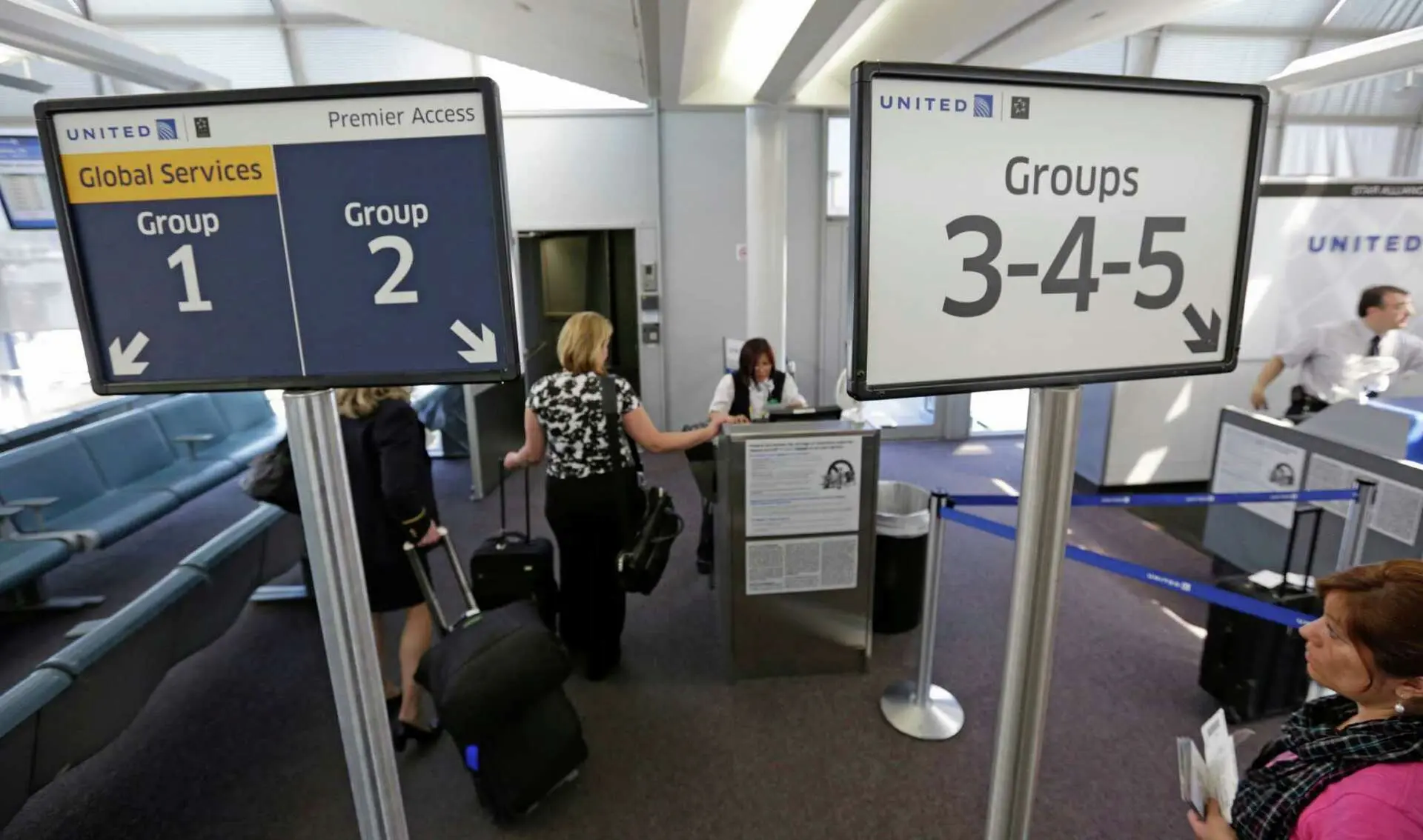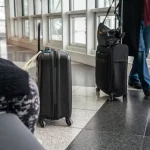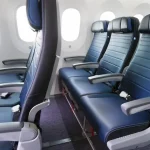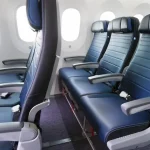The moment a United gate agent picks up the mic and starts calling groups, the calm waiting area turns into a controlled shuffle: passengers spring up too early or others crowd the lane.
If you’ve flown United Airlines, this scenario probably feels familiar. While United’s boarding process is structured, it can also seem confusing if you don’t know what your group number means. But here’s the truth: those numbers on your boarding pass aren’t random. They determine whether you get coveted overhead bin space, how much time you spend waiting in line, and even how relaxed you feel settling into your seat.
This guide explains the new WILMA system (window–middle–aisle boarding), and expert tips on how to board smarter, even if you don’t have elite status.
What Are United Airlines Boarding Groups?
United organizes passengers into pre-boarding plus six numbered boarding groups (1–6). Within that, the system reflects a mix of:
- Fare class (Basic Economy, Economy, Economy Plus, Polaris, First/Business)
- Elite loyalty status in MileagePlus or Star Alliance
- United co-branded credit card holders
- Purchased add-ons like Premier Access or Priority Boarding
It’s not just about hierarchy, it’s about efficiency. United’s boarding design helps:
- Reduce bottlenecks in the aisle.
- Speed up aircraft loading (minutes matter when you’re turning planes).
- Reward loyal customers and premium flyers with early boarding.
Your boarding group number is automatically assigned when you book and is displayed both on your boarding pass and in the United app.
How Does the United Airlines Boarding Process Work?
United boards in a predictable sequence:
- Pre-boarding
- Passengers who need extra time, have disabilities, unaccompanied minors, active military, and families with children under 2.
- Some top elites (Global Services, Premier 1K) are also called here.
- Group 1
- Premium cabins: United Polaris, United First, Business Class.
- Top-tier MileagePlus elites.
- Group 2
- Premier Silver, Priority Boarding purchases, Premier Access buyers, Star Alliance Gold, and some United credit card holders.
- Groups 3–5: WILMA system
- Group 3: Economy passengers with window seats.
- Group 4: Middle-seat passengers.
- Group 5: Aisle-seat passengers.
- Group 6
- Basic Economy passengers (last to board, often with limited carry-on privileges).
At many airports, United uses a two-lane gate setup (blue and green lanes). Groups 1–2 usually board through the blue lane, while Groups 3–6 board via green, making the process smoother.
WILMA Boarding: Window, Middle, Aisle
One of the most interesting changes United made in 2023 was adopting WILMA boarding — seating groups based on seat position:
- Window seat passengers go first.
- Middle seat passengers go second.
- Aisle seat passengers go last.
This helps to minimizes seat crossovers and allows multiple passengers to stow bags and sit simultaneously.
The result:
- Boarding is up to 2 minutes faster per flight, according to United’s testing.
- Fewer awkward “excuse me” seat swaps while people are still loading.
- Better flow down the aisle.
This might sound like a small change, but across United’s thousands of daily flights, it’s a huge operational win.
Complete Breakdown of United Boarding Groups
Here’s a clear snapshot of who boards when:
| Group | Who Boards | Typical Cabin/Notes |
| Pre-boarding | Customers needing assistance, families with kids <2, active military, Global Services, Premier 1K (sometimes) | Any cabin |
| Group 1 | Polaris, First Class, Business Class, some top-tier Premier | Premium cabins |
| Group 2 | Premier Silver, Priority Boarding buyers, Premier Access, Star Alliance Gold, some United cardholders | Front economy or upgraded |
| Group 3 | Economy passengers with window seats | Economy (WILMA) |
| Group 4 | Economy passengers with middle seats | Economy (WILMA) |
| Group 5 | Economy passengers with aisle seats | Economy (WILMA) |
| Group 6 | Basic Economy (last) | Economy (restrictions apply) |
Who Boards First on United Airlines Flights?
- Pre-boarding is first: those needing assistance, young families, active military, unaccompanied minors, and sometimes Global Services or Premier 1K.
- Premium cabins (Group 1) follow: Polaris and First/Business Class.
- Elites and cardholders then trickle in with Group 2.
If you’ve ever wondered why you saw someone in coach boarding before you — it’s likely because they chose a window seat (Group 3) while you picked an aisle (Group 5).
Economy vs. Basic Economy Boarding
This is where confusion hits many travelers. The difference between Economy and Basic Economy affects when (and how) you board.
| Feature | Standard Economy | Basic Economy |
| Carry-on bag | Allowed | Personal item only (exceptions on int’l routes) |
| Seat selection | During booking | Random at check-in |
| Boarding group | Group 3–5 (depending on seat) | Group 6 (last) |
| MileagePlus upgrades | Eligible | Not eligible |
| Changes/refunds | Standard policy | Restricted/no changes |
If overhead bin space is important to you, Basic Economy is a gamble. You’ll board last and likely need to gate-check a bag.
How to Get a Better Boarding Group on United
Not a Premier elite? No problem. There are multiple ways to move up the boarding ladder:
- Fly Premium Cabins: booking Polaris, First, or Business automatically lands you in Group 1.
- Use a United co-branded credit card: the United Explorer Card and Club Infinite Card give you Group 2 or 3.
- Join MileagePlus loyalty program: Premier Silver status starts at Group 2, while higher levels get you Group 1 or pre-boarding.
- Pay for Premier Access or Priority Boarding: purchasable add-ons during booking or at the gate.
- Book a window seat: under WILMA, this pushes you into Group 3 instead of 5.
- Fly with a Star Alliance partner: Gold status on Lufthansa, ANA, Singapore Airlines, etc., applies on United.
- Travel on the same reservation: companions are grouped with the highest boarding group on the booking.
Practical Traveler Tips to Board Smarter
- Download the United app: it updates your boarding group and sends push alerts when boarding begins.
- Arrive early: United often starts boarding 40–50 minutes before departure.
- Avoid the crowd: Don’t hover near the gate if you’re Group 5 or 6 — it slows everyone down.
- Pack smart: If you’re in Group 6, bring only a personal item to avoid last-minute gate-check fees.
- Check seat strategy: If you want earlier boarding without paying more, choose a window seat when booking.
- Travel light: Checked bags reduce boarding stress and mean you don’t have to rush for overhead bin space.
How United’s Boarding Compares with Other Airlines
Airlines all claim their boarding process is “efficient,” but each has its quirks:
- American Airlines: Also boards in Groups 1–9, but places more emphasis on loyalty tiers and less on seat type.
- Delta Air Lines: Uses branded categories (Sky Priority, Comfort+, Main Cabin 1, etc.) rather than numbers — easier branding, but less transparent.
- Southwest Airlines: The outlier — no assigned seats. Boarding order depends on check-in time (A1–C60).
Compared to peers, United’s system is more structured than Delta, less chaotic than Southwest, and rewards loyalty like American, but with the unique WILMA twist.
Common Boarding Mistakes Travelers Make
Even seasoned travelers slip up. These five errors slow you down and frustrate everyone else:
- Arriving at the gate late – boarding often starts earlier than people expect.
- Lining up too early – crowding the lane before your group is called only slows boarding.
- Ignoring carry-on rules – especially in Basic Economy, leading to forced gate-checks.
- Not refreshing boarding passes – screenshots don’t update if gates change; use the live United app version.
- Confusing seat row with boarding group – your seat number doesn’t dictate when you board.
Key Takeaways
United’s boarding system might seem complicated at first glance, but once you understand the logic behind the groups, it becomes much easier to strategize. Whether you’re a frequent flyer chasing status, a casual traveler trying to avoid gate-checks, or a parent managing kids, knowing when and how you’ll board takes away a huge layer of stress.
At the end of the day, boarding earlier means less hassle, more bin space, and a smoother start to your flight. And with tricks like choosing a window seat, holding a United card, or buying Priority Boarding, you don’t need elite status to get there.
Frequently Asked Questions (FAQ)
How many boarding groups does United have?
United boards via pre-boarding plus six numbered groups (1–6), with WILMA applied to Groups 3–5.
What is WILMA, and how does it affect me?
WILMA means Window, Middle, Aisle. It determines boarding order for economy passengers, making boarding faster and less congested.
Can I buy priority boarding?
Yes. United sells Priority Boarding and Premier Access, both of which place you in Group 2.
Will my Basic Economy fare on United Airlines allow a carry-on?
Usually no — domestic Basic Economy allows just a personal item, unless you hold elite status or a United credit card.
Can families or groups with different boarding groups board together on United Airlines?
Yes, but they must board with the highest group number in the reservation (i.e., the later group).





